Gurbaksh Singh Dhillon
| Author:Laxman Burdak, IFS (R) |
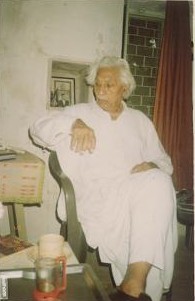
Gurbaksh Singh Dhillon (b.March 18, 1914 - d.February 6, 2006), popularly known as Col. G.S. Dhillon, was an officer in the Indian National Army who was charged with "waging war against His Majesty the King Emperor". Along with Gen. Shah Nawaz Khan and Col. Prem Kumar Sahgal, he was tried by the British at the end of World War II in the INA trials that began on November 5, 1945 at Red Fort. Dhillon also played an important role in the Indian independence negotiations. Mr. K.R. Narayanan, president of India, awarded Padma Bhushan to Col. Gurbaksh Singh Dhillon on 12 April 1998.
Heritage
- This section is From Chapter-2 Heritage of book by Dhillon, Gurbaksh Singh (1998): From My Bones, New Delhi: Aryan Books International. ISBN 81-7305-148-8. pp.5-9
The Indo-Aryan stock is tall, sturdy, strong, handsome, industrious and adventurous. Though varying in religious beliefs and practices, the Jats predominantly inhabit areas falling in Pakistan, Punjab, Haryana and Western Uttar Pradesh of India. Besides constituting the finest peasantry of the subcontinent, the Jat community has produced valiant warriors, poets, patriots, great administrators, eminent scholars, saints and sages throughout the ages. Their clans are named after their Gotras, sub-castes or clans. My father and mother were descendants of the Dhillon and Dhariwal Sikh Jat Clans, respectively. (p.5)
The Dhillons enjoy recognition and a status among their Jat brethren. They are often addressed as 'Dhillon Padshah' - Dhillon Majesty. This courtesy shown by a Jat to a Jat is gratifying, for a Jat, though simple and straightforward, is sensitively self-respecting and proud of his birth irrespective of his station in life but choosy in bestowing praise on others. The Dhillons owe their happy position to the outstanding exploits of their forefathers in the field of war and statecraft, apart from their generally easy-going and genial nature. (p.5)
Early in the eighteenth century during the decline of the Mughal empire, four Dhillon Hindu Jats -- Chaudhuries Chhaja Singh, Bhim Singh, Mala Singh and Jagat Singh- of Panjwar, a village eight miles from Amritsar, embraced Sikhism. Under the command of Sardar Chhaja Singh they set up a Dal comprising a force of twelve thousand strong. It was the first of the twelve Sikh Misls which came into being during that period. It was named the Panjwarya Misl but more commonly called the Bhangi Misl, because they were fond of bhang,
Dhillon, Gurbaksh Singh (1998): From My Bones, End of page 5
an intoxicating drink made of the leaves of hemp.
After the death of Sardar Chhaja Singh, Sardar Bhim Singh led the Misl successfully with ability, making it a well equipped, organized and disciplined force. With Amritsar as their base, they operated far and wide. The capture of the big gun, the Zamzama at Ramnagar and the occupation of Lahore which they held for thirty years, are some of their outstand1Og exploits. Zamzama is displayed as a show-piece of history in front of the Museum at Lahore. It is popularly called "Bhangion ki Tope" after the name of the Misl. The Misl held sway over most of the Manjha region of the Punjab till the advent of Maharaja Ranjit Singh of the Sukerchakya Misl who occupied Lahore in 1799 and set up his Raj as the sole sovereign of the Punjab.
But more important than the military and political exploits are the attainment of a simple peasant - an old man-the venerable Baba Buddha. He was held in such a high esteem by the successive Sikh Gurus that he is believed to have enjoyed the unique honour of having been called to install six out of the ten Gurus on the spiritual throne, the Gaddi, though actually he did install five Gurus for Guru Nanak has not been formally installed by anybody. He spent much of his active in the jungles around Jhabal (Beer) near Amritsar where he reared his herd of cattle. A simple and pious Randhawa Jat Baba Buddha was the pride of all Sikh Jats and the Sikhs.
Far from pretending any claim to the great Dhillon dynasties, I have enjoyed being Just a Dhillon right from my childhood. This natural sense of belonging to the lineage has been responsible to an extent in molding my own character.
My family was of a humble origin. Narwar, our ancestral village, is in Lahore district today as it was before the partition of India. It is about 28 kilometres from Amritsar across the border. My grandfather, Sardar Jawahar Singh was of an ascetic temperament and devoted all his time to prayers and to the service of the Sikh temple (gurudwara). The granthi (Sikh priest) was so much enamoured of him that he married his daughter, his only child to Jawahar Singh. Out of this wedlock were born two sons, Sardar Harbhajan Singh and Sardar Natha Singh.
Sardar Harbhajan Singh was my grandfather. He learnt Urdu and
Dhillon, Gurbaksh Singh (1998): From My Bones, End of page 6
and Persian and was employed as a Patwari, the lowest revenue official.
As a mark of appreciation of his diligence and creditable service, He was promoted as Kanungo, land revenue inspector. Towards the end of the nineteenth century with the advent of canals when new colonies were opened in the Punjab, he was awarded a murabba, 25 acres of under the upper Bari Doab canal in Chak No. 32 near Chhanga Manga in Chunian tehsll of Lahore distinct. After retirement, he migrated to the new land. In those days it was quite a challenge to reclaim a virgin forest.
Incidentally, my grandfather lost his eyesight. My recollections of him are that of a blind old man walking with a stick holding someone's hand. He had a terrible temper and it was not a pleasant job to lead him but somehow I loved his company on long evening walks along the canal bank near our village. Once I asked him, "Babaji, How did you lose your eyesight?". He said, "One day as I was crossing the canal over the bridge, I saw some women bathing naked in the canal. I stood there to watch them. They got annoyed and cursed me, so I got blind". I asked, "Babaji I have seen pictures of Lord Krishna hiding in a tree with women's clothes and the women concealing their bodies in the river water. Didn't they curse Krishna? Why didn't He go blind like you?" The grandpa replied, "You see, it is the intention of an act which determines the ethics of it. Bhagwan Krishna was the greatest Master, a Divine Teacher. He intended to teach those girls a lesson not to take naked bath in the open. Krishna was holy. I was wicked, so I got blind". My grand-father died in 1928 when I was just a student of the 7th standard.
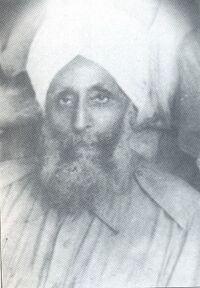
My father Sardar Thakar Singh was the first child of his parents. He was three days old when his mother died and was brought up by his mother's younger sister Har Kaur, called Haro, whom my grandfather married. Since she remained childless, grandfather Contracted another marriage with Maalaan, who gave birth to three sons and two daughters, all very much younger than my father. As the eldest son, my father shared with grandfather the responsibility of bringing up his younger brothers and sisters. Bebe Maalaan died early. I do not remember seeing her.
As far as we children were concerned, Bebe Haro was our grandmother. She always lived with my parents. We fondly addressed
Dhillon, Gurbaksh Singh (1998): From My Bones, End of page 7
her as Bebe. Short of stature but lofty in ideas, she offered a wonderful company. As I look back, I can still visualize being cuddled up in her warm bed along with other children listening to the bedtime stories as she quietly distributed dried fruit, candy or sweets and parched corn or gram which she saved for us out of her own share. I have always cherished the heavenly bliss that tenderly enveloped us in complete fearlessness and sense of sublime security under her wings.
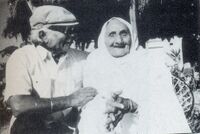
The Bebe had a kind heart. She loved animals and each morning would be seen feeding small birds, sparrows and doves, filling little bowls with water for birds and dogs. During the hot summer noon, she would personally water and bathe little calves. She enjoyed excellent health. I never saw her ill. She was her own doctor, prescribing simple treatments. Her curative agents were hot or cold water and milk, sugared or salted curds, butter or mustard oil massage, hot or cold bath, alum, camphor, asafoetida, garlic, onions and honey taken in different doses and in different ways.
She had a great sense of humour and would make us laugh with her anecdotes narrated in a poetic vein. Amrik, my younger brother, once remarked, "If Bebe had been to school she would have become a great poet". She lived a long life spanning over 90 years and died in 1944 of sheer old age, the only disease for which there is no cure. My mother often used to say, "I owe all my happiness and prosperity to Bebe's blessings. May god bless her soul! She never scolded me as mothers-in-law would".
My father started his education rather late. There was no school in the village. He had to go all the way to Lahore even for primary education, where he lived in a rented room shared by other boys from the village. They had to cook for themselves and would come home on weekends.
My father got married when he was still a child: he passed 4th class after his marriage. Being a bright student, he wished to go in for higher education but grandfather decided otherwise, which would save him two rupees a month. Fourth class was considered a standard of qualification good enough for getting a clerical job. My father had just attained his majority and it was considered proper that he should start earning for himself and for the family. My father did not wish to
Dhillon, Gurbaksh Singh (1998): From My Bones, End of page 8
have an office Job because he wanted to be a soldier. Accordantly, he presented himself before the Recruiting Officer at Lahore for enlistment in a cavalry unit. To his disappointment, his chest was found two inches too small. He was told to go back, build up his chest and report thereafter.
....Then he went to the recruiting officer and got enlisted as a sawar in 8th K G O (King George's Own) Light Cavalry. He got an early promotion and was selected as to be trained as a veterinary surgeon. He happened to be stationed at Firozpur when I was born.
Dhillon, Gurbaksh Singh (1998): From My Bones, End of page 9
Childhood
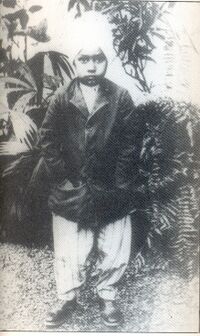
Gurbaksh Singh Dhillon was born at Algon on 18 March 1914. His father and mother were descendants of the Dhillon and Dhariwal Sikh Jat clans, respectively. He was the fourth child of his parents. His childhood name was Bakshi. His father was Sardar Takhar Singh and was employed in 8th King George’s Own light cavalry. He was promoted to post of Veterinary surgeon. Gurbaksh Singh was born when Takhar Singh was posted at Firozpur.(p.10)
Education
Gurbaksh Singh's early education was at Changa Manga, a Government primary school. After passing 4th class he got education in number of schools, namely, Government High School, Chunian in Lahore district; Government High School, Dipalpore in district Montgomery; Vernacular Middle School, Raiwind in district Lahore; Victoria Dalip High School, Solan in Baghat State of Simla Hills; Dayanand Anglo Vernacular High School, Montgomery and lastly Gordon Mission College, Rawalpindi. (p.17)
Chunian was the birthplace of Raja Todar Mal.(p.18)
He got education from teachers belonging to various religions that made him a secular person. He was a member of the Boy Scout Association. He has knowledge of Persian, Urdu, Hindi, Punjabi and English languages.(p.21)
In 1931, he passed his High School from Dayanand Anglo Vernacular High School, Montgomery and joined Faculty of Science in Gordon Mission College,Rawalpind. (p.26)
He failed to qualify F.Sc. examination of Punjab University in 1933. This ended his dream of becoming a doctor. Early that year his father had retired from service. With matriculation only he was unable to get any job.(p.28)
Personal life
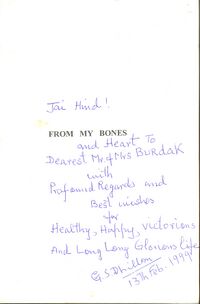
Dhillon married to Basant at age of fourteen in 1928. Their first child, Amrita, was born on 15 April 1947 at Simla. Amrita studied at Banasthali Vidyapith for eleven years and later became a doctor. Dhillon has two sons Amarjit and Sarvjit. Both are settled at Shivpuri. His wife Basant died on 19 March 1968 at Shivpuri. Gurbaksh Singh Dhillon was living in Dhillon’s Den at the village Hatod in Shivpuri district of Madhya Pradesh during his last days of life.
Army enlistment
Mr. J.F.L. Taylor, a friend of his father, suggested to join the Indian Army as a combatant in the lowest rank as sepoy and further improve his educational standard. So he joined as a sepoy in Training Battalion, the 10/14th Punjab Regiment on May 29, 1933. (p.32)
As a recruit his pay was fifteen rupees per month. He completed his training in first week of March 1934. (p.37)
During June 1936, he was selected for training at Kitchner College, Nowgong as a prospective candidate for the Indian MilitaryAcademy Dehradun. (p.50)
From Nowgong, he was sent to his parent unit, 4/14 Punjab Regiment, which had moved from Lahore to Chaman near Afghan border and from there to Dehradun. (p.56)
At the IMA he was considered an average cadet. The start of World War II cut short his training in the Academy by one term and he graduated in March 1940. He was posted to the 1st Battalion of the 14th Punjab Regiment, which was called "Sher Dil Paltan". He joined this Battalion on the last day of March 1940 at Lahore in the same barracks where he had been a sepoy in the 4th Battalion of the Punjab Regiment. (p.61)
He shared bungalow here with Lt. R.N. Nehra who was living with his family. One of the last batch from Sandhurst, his wife was very good neighbour to live with., reserve, non-interfering and courteous. Within a couple of months Nehra got his posting at Dehradun as an Instructor at the IMA. (p.62)
His Battalion moved from Lahore to Secunderabad in September 1940.(p.68)
Overseas move
Soon after the second week of February 1941, Dhillon and his battalion were ordered to move overseas. Left Secunderabad on 3 March 1941 for Penang Island and from there to Ipoh, north of Kuala Lumpur in Malaya. After about two months stay at Ipoh, their Battalion moved to Sungei Pattani in South Kedah as a part of the 5th Indian Infantry Brigade under Brigadier Garrett.
The 3rd Cavalry was allotted the defence of the Island of Penang. He disembarked at Singapore and reported at 7 MRC, Mixed Reinforcement Camp at Bidadari. From Singapore he was sent to Jitra situated on the main road to Thailand, 16 miles (26 km) south of the border. He arrived Jitra on December 5, 1941.
Dhillon in World War II
Following the attack on Pearl Harbor and the bombing of Singapore on the early morning of 7 December 1941, the United States declared war on Japan. The Japanese forces completely destroyed the squadrons of the Royal Air Force at Sungei, Alor Star and Kota Bharu airfields. On December 11, 1941, 1/14th Punjab Regiment fought a pitched battle at Changlun near the Thai frontier. Dhillon commanded the Headquarters Company with his C.O. Col. Fitzpatrick who remained nearest to the front line. The Battle of Changlun went on for eight hours and was lost. The Alor Star had also fallen.
On December 13, 1941 they arrived at Miami Beach? near Penang. They were taken to 3 M.R.C. in Penang. At the same time it was ordered to evacuate Penang. They were given the duty to guard a railway bridge at Nibong Tabol. They guarded the bridge for another two days till the arrival of Japanese. Then they were ordered to withdraw to Ipoh where Dhillon fell ill with malaria. He was hospitalized and sent to Singapore.
By the dawn of 9 February 1941, almost two divisions of the Japanese had landed on the soil of Singapore. On February 10, 1941, 7 MRC was moved to Raffles Square, a business area. By that time it was apparent that the surrender of Singapore was imminent. On February 13, 1941, Raffles Square was bombed. 7MRC suffered heavily with about 300 killed and many more wounded. The second-in-Command of 7 MRC, an English Major and Dhillon had a difficult job disposing of corpses. They dropped them in ocean. Singapore capitulated on February 15, 1941 and British Forces surrendered unconditionally to the Japanese.
The defeated and demoralized Indian soldiers collected themselves at Farrer Park in Singapore. Major Fujiwara addressing the POWs expressed that it was his firm belief that world peace and the liberation of Asia could not be achieved and maintained without a free and independent India. He further said that if Indian POWs in Malaya were prepared to fight the British imperialism for the noble cause of achieving the independence of their motherland, the Imperial Japanese Government would advance all out support. He suggested the formation of Indian National Army. He handed over all the POWs in Malaya to Capt. Mohan Singh, the G.O.C. of the Indian National Army.
Indian National Army
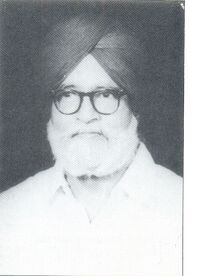
At the stage on Farrer Park Capt. Mohan Singh addressed the POWs and decided to form an organized and disciplined power in the form of Indian National Army. The erstwhile POWs were to become now the soldiers of India’s Army of Liberation, the army that was to fight under its own leadership, with a real and just cause to wage war.
Mohan Singh was from the same unit from which was Dhillon. He was a close friend of Dhillon. On February 17, 1942, Dhillon decided to join the Indian National Army and took the vow not to drink till India became free. Next morning Capt. Mohan Singh issued orders to march off all the units of various camps on the island where the units were to occupy their allotted accommodation. Dhillon’s unit was to proceed to Neesoon Camp. Neesoon village was situated 13 miles (21 km) away from main town of Singapore. This camp was the Regimental Centre of the Hong Kong and Singapore Royal Artillery.
The Japanese Headquarters had asked the Supreme Headquarters to provide 200 officers to guard the British and Australian prisoners of war at Changi Camp. Dhillon took the risk and volunteered his services for this unpleasant task. At Changi Camp, Dhillon and other Indians were asked by the Japanese to give up the British drill and words of command and adopt Japanese ones. Within a fortnight they learnt the Japanese drill and words of command. Here they kept the Allied POWs in five separate Camps – Australian Camp, Hospital area, 9th Indian Division Camp, 11th Indian Division Camp and 18th British Camp. Its own officer, usually a General residing in the Camp, commanded each Camp. Changi was under military control of Japanese as well as Dhillon. Dhillon inculcated amongst the prisoners the feelings of national unity, discipline and keen sense of duty through daily lectures personally delivered by him. After some time at Changi Camp Dhillon fell seriously ill. He was released from the command of the Changi Garrison and sent to Seletar Camp and was admitted to POW Hospital.
Shaping Indian National Army
Dhillon’s health improved at Seletar Camp. He along with over thirty important senior officers from among the Indian Prisoners of war attended the Bidadari conference called by Captain Mohan Singh at Bidadari Camp in Singapore on 24 April 1942. The resolutions of this Conference, came to be known as the "Bidadari Resolutions", formed the backbone of formation of INA. As resolved at the Tokyo Conference, a representative conference of the Indians who lived in East Asian countries was held at Bangkok on 15 June 1942, which continued for 10 days. Thirty INA volunteers nominated by Mohan Singh among the Indian prisoners of war attended it. A resolution was passed at this conference known as Bangkok Resolution. Dhillon got his National Commission on 1 September 1942 and was posted as major on the 10 September 1942. He was still ill so he was attached to the Reinforcement Group. The first review of INA was held at Singapore Padaung in front of the Municipal Buildings on October 2, 1942, the birthday of Mahatma Gandhi. Dhillon attended this function as an observer. The progress in recuperating Dhillon’s health was slow. He was recommended a month’s leave and sent to Penang. He returned to Singapore in the middle of November 1942. The Japanese had not yet ratified the Bangkok resolutions not recognized the INA as an independent army. General Mohan Singh had lost confidence in the Japanese. In the beginning of December 1942, the Japanese asked the INA Headquarters to dispatch an advance party to move to Burma so as to prepare camps and accommodation for the main body of INA. Meanwhile differences developed between Mohan Singh and the Japanese. The Japanese arrested General Mohan Singh on December 29, 1942. There was a period of crisis due to suspense and indecision. On the advice of Rash Behari Bose Dhillon continued in INA. They went all over the Island and up-country to urge men to remain in the INA. Meanwhile Subhas Chandra Bose (Netaji) was trying to come to the East. In anticipation of Netaji’s arrival, the revived INA was reorganized under its new headquarters known as Directorate of Military Bureau (DMB) with Col. J.K.Bhonsle as the Director. Dhillon was appointed as Deputy Quartermaster General (DQMG) in the "Q" Branch at the Army Headquarters. He was to look after the Technical Branch and was responsible for the accommodation also. The Army Headquarter was organized by the middle of March 1943 and was duly gazetted on April 17, 1943. On appointment Dhillon took up the task of collection of kit and clothing of those personnel who decided to leave the INA. When Netaji arrived on July 2, 1943 in Singapore and the Army was enlarged in December 1943, Dhillon was transferred to be the 2nd-in-Command of the 5th Guerilla Regiment.
The 5th Guerrilla Regiment
Dhillon was appointed Second-in-Command to Major J.W. Rodrigues in December 1943. Rodrigues raised the 5th Guerrilla regiment at Bidadari in Singapore. Apart from helping in raising the regiment Dhillon was responsible for training, discipline, morale and welfare of the troops. The 5th Guerrilla Regiment was formed as part of the 2nd INA Division, which was organized under the command of Col. N.S. Bhagat consequent on the 1st Division’s move to the Front. On March 30, 1944, the 5th Guerrilla Regiment moved to Ipoh in Perak state of Malaya. Dhillon proceeded with the advance party to make necessary arrangements for the Regiment.
Move to Burma
Dhillon was sent to front at Alor Star in Infantry Regiment at Jitra. On July 15, 1944 they left Jitra for onward journey Kawashi, Mergui and Tavoy through Thailand and then to Moulmein and Rangoon in Burma. They had a period of long stay at Bangkok. From Bangkok they flew on August 21, 1944 over to Rangoon by Netaji’s personal aircraft, the "Azad Hind". At Rangoon they were accommodated in Mingaladon Camp about 14 miles (23 km) from Rangoon. Dhillon was here officiating as the Deputy Adjutant General (DAG) and also the Deputy quartermaster General (DGMG) in the Divisional headquarters when the first anniversary of the Provisional Government of Azad Hind came about. As part of the celebrations of the anniversary, the review of the 2nd Division of the INA was arranged at Mingaladon. It was part of duties of Dhillon to make arrangements and issue orders for the ceremonial parade at the vast parade ground. The parade was held on 18 October 1944.
Subhash Chandra Bose
Dhillon met Subhash Chandra Bose on October 15, 1944 at his residence in Rangoon. He again met him on October 26, 1944 after which Dhillon was made Brigade Commander of the Nehru Brigade. Towards the end of 1943, "The Nehru" was put under the First Division. It moved to Burma in early 1944 and arrived at Mandalay. The Nehru Brigade was deployed in the Myingyan area with the object of defending it against enemy attack, which appeared imminent consequent on their withdrawal from Imphal.
In the middle of December 1944, the Japanese Army Commander General S. Katamura visited The Nehru Brigade along with the general came Col. I. Fujiwara, the greatest supporter of the INA and one of the originators of the idea among the Japanese. Dhillon was advised to expect the worst so that there was no disappointment later.
The Nehru Brigade held Irrawaddy
Gurbaksh Singh Dhillon[1] writes....Towards end of 1944, Netaji Subhash Chandra Bose gave Dhillon the command of 4th Guerrilla Regiment also called the Nehru Brigade. His regiment distinguished itself in the battlefield. The Nehru Brigade was to hold the Irrawaddy River from Nyaungu in north to Pagan in south, both towns inclusive, and to hold the enemy crossing the Irrawaddy at those places. (p.268)
Dhillon formed an advance party from 9th Battalion and left for Pagan on January 29, 1945. (p.265)
Dhillon ordered the move of battalions to leave Myingyan by February 4, 1945 so as to be in their respective positions by February 8, 1945.(p.268)
Dhillon ensured all the arrangements. The Nehru Brigade held the Irrawaddy as planned. Dhillon kept his Headquarters at Tetthe during this operation. (p.269)
On February 12, 1945 the enemy planes carried out saturation bombing on INA defences. (p.286)
On 13/14 February night enemy launched an assault in front of the 8th battalion deployed at Pagan. (p.288)
These assaults were failed and the enemy had to withdraw. The Nehru Brigade kept on holding the Irrawaddy and this was the first victory of INA. (p.289)
After the failure at Pagan the enemy tried another assault crossing opposite Nyaungu by using outboard motors and rubber boats. This assault was also failed and hundreds of enemies were killed or drowned. Having failed the enemy had no other choice but to retreat. This was another victory of INA. (p.289)
This could not sustain and INA had to withdraw and Dhillon had to proceed to Pagan.(p.296)
Dhillon reached Popa on February 17, 1945. on the following day, 18.2.1945, sahgal arrived. (p.301)
On February 23, 1945, General Shah Nawaz visited the Commander of Khanjo Butai and discussed co-ordination of Indo-Japanese operations in the Popa and Kyauk Padaung area. Col. Sahgal was given the task to prepare Popa as a strong base with the view to take up an offensive role. Dhillon’s Regiment, the 4th Guerrilla, was assigned the duty to check the enemy advance on to Kyauk Padaung from the west, where the British had established a strong bridgehead at Nyaungu. This was to be achieved by carrying out an extensive and persistent guerrilla warfare in the area between Popa, Kyauk Padaung (p.302) line in the east and as far forward towards the Irrawaddy as possible as to deny the enemy the use of Nyaungu-Kyauk-Padaullg-Meiktila metalled road for supplying reinforcements and supplies to his forces fighting in the battle of Meiktila. (p.303)
Shah Nawaz arrived Popa on 12 March 1945 and relieved Dhillon forthwith to join his regiment.(p.305)
On April 4, 1945 his Division Commander, Colonel Shah Nawaz Khan, ordered Dhillon to return from Khabok to Popa. By then 4th Guerrilla regiment had been in that area waging guerrilla warfare for over five weeks. (p.318)
Mount Popa and Kyaukpadaung was one pocket of resistance, which had so far defied all British attacks. Under constant raids by INA the British forces were forced to use longer routes that caused the British loss of time, greater consumption of petroleum products and frequent breakdowns of vehicles.(p.319)
From the beginning of April 1945 the strategic situation began to change rapidly. The enemy launched a three-pronged attack on Mount Popa and Kyaukpadaung area. On 5 April 1945 Dhillon was allotted the defence of Kyaukpadaung, south of Popa. In the second week of April there was daily bombing from air. (p.321)
Under the cover of this barrage the British forces advanced in their heavy tanks and armoured vehicles. There were very heavy casualties. The INA could not organize any defence. 2nd Division of the INA was to withdraw to Magwe, 100 miles (160 km) south on Irrawaddy. (p.322)
After completing the task of withdrawing from Magwe, they came to a village called Kanni. (p.327)
In the meantime, the Burmese army has declared war against Japan, and as such, the villagers did not co-operate with INA. Their retreat was fully under the control of General Aung San’s Army under the new name of People’s National Army, after having established a parallel government extending their hold over about 50 villages. They crossed Irrawaddy at Kama to reach Prome on May 1, 1945. Most of INA officers and men could not cross the river and they were stranded on the east bank of Irrawaddy. It was apparent by then, that they had lost the war. Rangoon had already been vacated. (p.333)
From Prome they took southeasterly direction to retreat through the jungles of the Pegu Yomas. Eleven days after leaving Prome, they reached at village called Wata about 20 miles (32 km) west of Pegu. There they learnt that Germany had surrendered. Japan was being heavily bombed daily. The British forces had occupied Pegu. Rangoon fell during the last week of April. Herein they decided that the surviving forces of INA should surrender to the British.(p.337)
Surrender of Indian National Army
On The May 17, 1945 the enemy encircled The Indian National Army. So they surrendered without any surrender ceremony. They were put into prison at Pegu. Shah Nawaz and Dhillon were taken to No. 3 Field Interrogation Centre under command of Major C. Ore on May 18, 1945. Later on May 31, Dhillon was sent to Rangoon Central Jail. On the June 9 1945 Shah Nawaz was brought from Pegu and put up with Dhillon in Rangoon Jail.
On July 1, 1945 Dhillon was brought to Calcutta by plane and from there, sent to Delhi by train. On July 6, 1945 he was put in the Red Fort and interrogated by Mr. Bannerjee of the Central Intelligence Department. The interrogation was over by the third week of July. On the August 6, 1945, Shah Nawaz, Sahgal and Dhillon were jointly summoned to the CSDIC for the first time. It was the beginning of the first INA trial at Red Fort. On September 17, 1945 the trio were served a copy of charge sheet. The main charge was waging war against the King. The news of trial was made public through the press and All India Radio.
The Red Fort trial
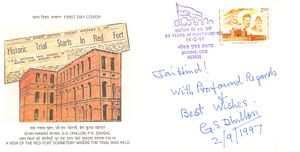
The historical trial of Gurbaksh Singh Dhillon, Prem Kumar Sahgal and Shah Nawaz Khan at the Red Fort began on November 5, 1945 by a General Court Martial for the charge of waging war against the King. When the trial began a mass demonstration was going on outside the Red Fort. People gave voice to their resentment on the trials by shouting:
- Lal Qile se aaee awaz,
- Sahgal Dhillon Shah Nawaz,
- Teenon ki ho umar daraz
(Meaning – Sahgal, Dhillon, Shah Nawaz, comes the voice from the Red Fort. May the trio live long)
The New Year's Eve December 31, 1945 was the last day of trial. The trial marked a significant turning point in India’s struggle for Independence and Col. Dhillon along with his two colleagues Col. Prem Kumar Sahgal and Maj. Gen. Shah Nawaz Khan became symbol of India fighting for freedom.
The verdict of trial came on January 1, 1946. All three were found guilty of waging war against the King Emperor. Having found the accused guilty of the charge of waging war, the court was bound to sentence the accused either to death or to deportation for life. No finding or sentence by court-martial is complete until confirmed by the Commander-in-Chief. Commander-in-Chief Auchinleck, taking into consideration the prevailing circumstances decided to treat all three accused in the same way in the matter of sentence, and decided to remit the sentences of deportation of life against all of the three accused, and they were later released.
Dhillon released
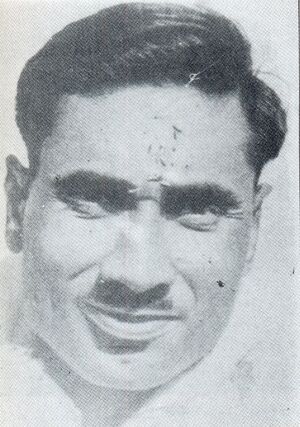
The incidence of release the three members of the INA was of momentous significance at national level. The unprecedented publicity in the national papers and the media during the proceedings of trial enhanced the credibility and legitimacy of the freedom struggle launched by Indian National Army. On the following day of the release, January 4, 1946 the whole of Delhi and its neighbourhood had gathered to participate the rally never organized in the history of Delhi.
Recognition
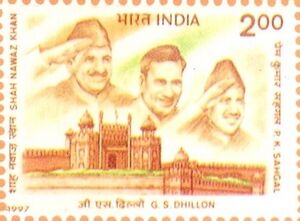
Mr. K.R. Narayanan, president of India, awarded Padma Bhushan to Col. Gurbaksh Singh Dhillon on 12 April 1998.
The Indian Postal Department issued a stamp in 1997 in the memory of Dhillon’s contribution to liberation of India.
Author had the occasion to visit Col. Dhillon many times when he was in Shivpuri. He gifted the author the First Day Cover issued by Indian Postal Department with his own signatures. I have uploaded here for general information. the Brochure by Indian Postal Department gives very useful informations on G S Dhillon, Shah nawazkhan and P K Sahgal which is reproduced below:
India's Struggle For Freedom Three INA Stalwarts
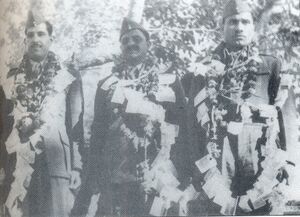
The end of the Second World War marked a dramatic change in the history of India's struggle for freedom. From then onwards till the dawn of freedom in 1947, the political stage witnessed a wide spectrum of popular initiatives and perhaps the most significant, were the mass demonstrations of popular anger against the trials of INA personnel. After the final surrender by the INA to the British in South East Asia, the Government decided to try for sedition a large number of those who fought for the country's freedom. The first trial began in 1945 at the historic Red Fort with three senior officers of the Azad Hind Fauz, Capt. Shah Nawaz Khan, Capt. P.K. Sahgal and Lt. G.S. Dhillon. They were charged with 'waging war against His Majesty the King-Emperor. .. .' .In reaction, people clashed with the police and many were killed. Workers went on a general political strike and normal life was paralysed. A strong team of lawyers including Bhulabhai Desai, Tej Bahadur Sapru and Jawaharlal Nehru defended the accused.
Pt. Jawaharlal Nehru the country's first Prime Minister commenting on this historic trial wrote in his foreword to "Two Historic Trials in Red Fort" edited by Moti Ram-
- "The legal issues were important enough... But behind the law there was something deeper and more vital, something that stirred the sub-conscious depths of the Indian mind. Those three officers and the Indian National Army became symbols of India fighting for her independence .... "
Shah Nawaz Khan
He was born at Rawalpindi on January 24, 1914. After attending a course at the Indian Military Academy at Dehradun he was granted regular commission in the Indian Land Forces w.e.f. February 1, 1936. In February next year he was posted to the 14th Punjab Regiment. While posted at Singapore Shah Nawaz Khan came under the influence of Netaji Subhas Chandra Bose and joined the Indian National Army. In September 1943 Netaji decided to select a regiment to spearhead the advance into India. It was known as the Sub has Brigade and Shah Nawaz Khan was selected to command it. He expired on 9.12.1982.
P.K. Sahgal
He was born at Hoshiarpur on January 25, 1917. He also attended a course al the Indian Military Academy, Dehradun and was granted regular commission in the Indian Land Forces from February 1st, 1939. He joined the I.N.A. in 1942, after a great deal of deliberations, "because I wanted freedom for my motherland and was ready to shed my blood for it." He expired on 16.10.1992
G.S. Dhillon
He was born at Algon on April 4, 1915 and also attended the Indian Military Academy, Dehradun and was granted regular commission in the Indian Land Forces w.e.f. April 1940. After the surrender of Singapore on 15.2.1942 to the Japanese, he joined then I.N.A. then organised by Capt Mohan Singh.
When the general Court Martial commenced on Novemmber 5, 1945, photographers were excluded from the court room as soon as the accused officers were brought in. Reuters, Associated Press of America and several of the British and American press covered the trial. The three accused officers were informed of the remission in the sentence of transportation for life by the Commander -In-Chief on January 3rd, 1946 and they were released from Red Fort the same evening. The INA spirit began to spread in the armed forces and there were strikes by Signalmen and other sections of the Indian Army, Air Force personnel, The Royal Indian Navy and hundreds of thousands of non-industrial workers. This marked a significant turning point in the history of events to follow as the British could no longer rely upon the Indian sepoys to maintain their hold on India. Pt Jawaharlal Nehru said in a speech in Bombay on 26th February 1946.
- "The INA episode and the recent Royal Indian Air Force and Royal Indian Navy strikes have rendered the country a very great service. The gull that separated people from the armed forces has once for all been bridged. The people and the soldier have come very close to each other. They have now come to realise that they both have one common aim - to free their country from the foreign yoke."
The stamp is an artist's depiction of Shah Nawaz Khan, PK. Sahgal and G.S Dhillon against the battlements of the Red Fort. The first day cover shows a sketch of the Red Fort dormitory where the trial was held along with the news item appearing in 'The Bombay Sentinel", of November 6, 1945.
The Department of Posts is issuing this special postage stamp on the trial of three senior INA officers as a mark of the nation's homage to the outstanding service rendered by three brave Indians and countless others who made the supreme sacrifice for the country's independence.
Credits :- Stamp design : S. Samanta, F.D.C. & Cancellation: Smt Alka Sharma, Text : Based on materials from -
- 1. India's struggle for Independence NCERT
- 2. India's struggle for Independence (1857-1947) Bipan Chandra
- 3. Two Historic Trials in Red Fort Edited by Moti Ram.
Col. Dhillon as Author
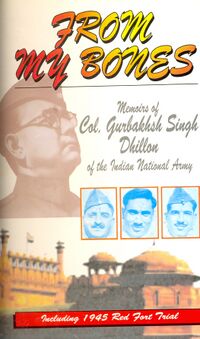
Col. G.S. Dhillon had also written a book titled From My Bones in which he has recorded experiences that contributed so significantly to India’s Independence. In this book Col. Dhillon narrates his experiences of INA and the nostalgic memories of the trial. The story narrated in the book is not the history of INA. The narrative is of the events, which concerned the author or were to his knowledge in connection with his duties and status in the movement. It is more like a historical account of his actions. He was also a poet. Though not a prolific poet, his poems vividly capture some of the momentous happening of recent history.
Death
Col G S Dhillon died on February 6, 2006 in the Intensive-Care-Unit of J.A.Group of Hospitals, Gwalior (M.P.) following a cardiac arrest after prolonged illness. His last rites were performed at Shivpuri with full military honours on February 8, 2006.
First Death anniversary
At the First Death Anniversary of Col.Dhillon, on February 6, 2007, A large number of people from different sections of society, gathered at his Memorial - AZAD HIND PARK (the place in village Hatod of Shivpuri where his cremation took place on 8 February 2006) to pay their tributes. Various freedom fightes, government officials, politicians, large number of school children, his friends & relatives along with local residents paid their homage to Col. on the occasion
See also
Gallery of pictures about Dhillon
-
Brochure on Stamp issued on G S Dhillon
-
Azad Hind Expedition Members (1995-96)
-
Azad Hind Expedition Members (1995-96)GS Dhillon at Mt Popa
-
Gurbaksh Singh Dhillon
-
Further reading
Dhillon, Gurbaksh Singh (1998): From My Bones, New Delhi: Aryan Books International. ISBN 81-7305-148-8.
References
- ↑ Dhillon, Gurbaksh Singh (1998): From My Bones, New Delhi: Aryan Books International. ISBN 81-7305-148-8. ,pp.265-337
Back to The Leaders






